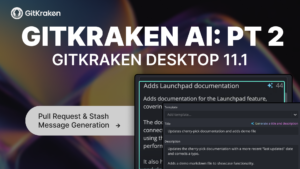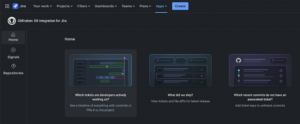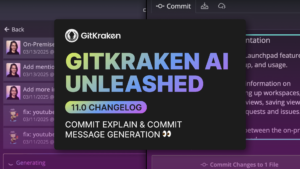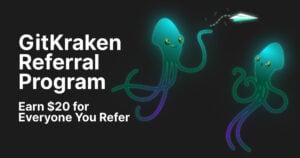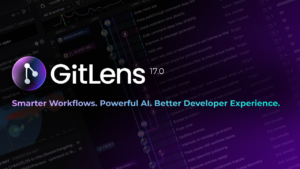This post is part of our new blog and video series dedicated to the “First 5 Years in Software Development.” This series was created specifically for early professionals coming out of school, as well as those who may be making a career change from another field or role into software development. Topics will include how to get your first development internship, tips for optimizing your resume, advice for your job search and interviews, navigating the corporate ladder, and more. Stay tuned for new posts and videos each month.
Today’s guest is Sydney Edman. Sydney is the People Operations Manager at GitKraken. She has been with GitKraken for a little under four years, starting as a Technical Recruiter before transitioning into HR/People Operations. Her career has been primarily focused in the tech space and specifically technology startups. In her role, Sydney acts as an advocate for employees and candidates, and a liaison between GitKraken and each of those groups.
Onboarding & The First Few Weeks: What Can New Software Developers Expect?
Even if people are really excited to join a new company, that transition into the company is going to be a little chaotic. It’s a major life event. On both the employer and employee side, there is an opportunity to set the process – and individuals – up for success.
At GitKraken, we structure our onboarding to be between four and six weeks. And we structure it to include both higher level company and product education, plus the in-the-weeds technical information that someone needs to be able to do their job. And one thing we try to prioritize is making sure new hires see the bigger picture in terms of how their role impacts the company.
Structured or Unstructured Onboarding: What’s More Common?
That often depends on the size and maturity of the company that you’re going into. The experience can range. Some companies may say ‘okay, here’s your equipment – and a self-guided onboarding direction – have fun!’ And on the flip side of that, some companies will provide a very structured and perhaps even rigid onboarding process. Of course there is a middle ground as well.
I personally like to see structure for at least the first several days to weeks, with learning objectives and milestones throughout, and that’s how we’ve set it up at GitKraken.
Mental Preparation: How Can Software Developers Get Ready to Maximize Their Onboarding?
Some years back, I was starting a new job. I remember I was going through onboarding with one of my coworkers and she shared a little sentiment that has stayed with me through my career. She said “you’re going to be getting a lot of information throughout your onboarding and there’s no way that you can retain it all. You can take as detailed notes as you possibly can, and we can provide you with all of the resources in the world, but there are still going to be questions that you need to know the answer to. Don’t be afraid to ask questions even two or three times if you have to. There aren’t many people that would not want to hear a question three times if the alternative is someone doing something incorrectly.
I think this applies to both technical and non-technical folks. The bulk of what you’re doing is learning and soaking up information. So, the biggest tip that I can give to developers who are going through onboarding is know when to ask questions and what questions to ask, and don’t be afraid to ask them.
Warm Welcomes: Who Will You Meet During Onboarding?
When I think about the key players that someone is meeting during their onboarding, there are two pools. The first pool is made up of your immediate team and peers. This includes your manager, various team leads, people that you’re going to be communicating with and working alongside daily and weekly. The second pool is comprised of cross-departmental individuals who you may have occasional interactions or dependencies with. This includes customer success, sales, or customer support.
Generally, the bulk of onboarding is focused on that first pool of people. But that second pool of people is equally as important. Especially in those first few weeks or first few months, it’s important to be building connections across the company that you may need to lean on down the road.
First Impressions: How to Nail the Early Introductions
Don’t limit yourself only to the people or teams listed on your onboarding plan. New developers entering a company should feel free to reach out to anyone that they think might be impactful in their journey. And it won’t be unwelcome.
And this is a time when people have the opportunity to showcase their personality. First impressions are really important, and you want to set yourself up for success in a way that goes beyond just knowing the technical aspects of your role.
You’re going to give your personal blurb several times to different individuals and groups. You may start to feel a little bit like a broken record. But how you nail the introduction is going to depend a lot on the company that you’re joining and the team that you’re talking to. It’s really important to know your audience and gauge what type of information they’re looking for in an introduction.
If it’s a more formal meeting or a meeting with executives, or perhaps a large group, it is generally best to keep it simple and stick to name, role, and a sentence about your relevant experience. If the meeting is with your peers or it’s more casual, then you may have a little more flexibility to be kind of playful with your introduction and give a little more information about your interests and your hobbies outside of work, and perhaps spend a little more time diving deeper into your background.
Asking Questions: Are Any Questions Considered Out-of-Bounds?
My answer to this is going to be potentially a little bit different than expected coming from someone who works in HR. To me, it’s less important to know what is appropriate versus inappropriate than it is to know your audience and make sure you’re managing your perception. For example, you wouldn’t want to ask your boss’s boss if you can expense your lunch. But you might feel more comfortable asking that of a peer or someone who is in HR and on the benefits side of things.
I would say there aren’t really any out of bounds questions related to benefits. And overall, it’s just about knowing who to go to to get the answer to that question.
Onboarding Complete: Now What? How Do Expectations Change?
The learning is never going to be over. Coming out of onboarding, the biggest shift in expectations here is that you will have a better grasp on your role and the overall organization, so your Manager will expect you to be equipped to teach yourself more independently and proactively seek out whatever resources you need to be effective.
Staying Connected When Remote: What Are Some Tips for Remote Software Developers to Stay Close with Their Team?
Working remotely means that we have to be more intentional about staying connected to our coworkers. My number one tip is to use the tools that are at your disposal, whether that’s Slack or Teams or Google. All of these tools have features designed to help employees stay connected, especially in a remote or distributed or asynchronous environment. Take advantage of video chats, voice messaging, and collaborative docs.
And continue to connect above and beyond the day to day work. If you’re comfortable, share pictures of your pets, your travel adventures, hobbies, etc. This kind of sharing and connection goes a long way towards strengthening camaraderie.
I’m also seeing a bit of a comeback in the good old-fashioned phone call. It’s a good reminder that video chats and typing aren’t the only options. A phone call can still create a personal touch and offer a welcome break from the screen.
Personal Workspace & Routine: What are Some Tips for Setting Up the Ideal Space & Schedule?
This is going to come down to personal preference and what works best for you. The nice thing about the shift that we’re seeing in the industry towards remote work is that we have a lot more options. In the morning, you may work from your desk in your home, and in the afternoon you may go work from a coffee shop or the library. It’s important to find the environments that work for you, and also the routine.
A quick personal anecdote. When we transitioned to primarily working remotely, I had been used to a pretty rigid schedule. I would get up at five in the morning and go to the gym, and then I would head to the office for my workday, and I’d usually leave around the same time and run some errands on the way home. This was every day, Monday through Friday. And when the pandemic started and I started working from home, at first I tried to keep that same type of rigid schedule where. But I quickly learned that that routine wasn’t going to work for me. The point in which remote work started really working for me was when I realized that I didn’t need to wake up at 5am to go to the gym. I wasn’t fighting traffic or having to spend the same time on my morning routine. I could go to the gym during my lunch break, which isn’t something I’ve ever been able to do before.
Learning what type of routine worked for me really helped my productivity a lot. So I believe it’s important to figure out what works best for you. Obviously the caveat here is making sure you are creating a routine that respects the responsibilities of your role and team.
Preventing Burnout: Advice to Help Software Engineers Maintain Sanity and Balance
Developers tend to work in sprints. Periods of intense focus and productivity. Giving yourself a little bit of downtime, potentially scheduled downtime, throughout the day or week is really important.
We all understand how it can be when we get in the zone and we don’t look away from our computer for four or five hours. But we need to remind ourselves to step away from the computer as often as you need. That can even mean a non-screen based conversation with a coworker. These little breaks can help you sustain your focus when it’s time for the next sprint.
There’s a platform that several people here at GitKraken use. It’s called Reclaim. It integrates with Google calendar and it’ll automatically block off time for you during the day at, at whatever cadence you’d like. I have it set to schedule me to go on three 30-minute walks per week, and I know some people have it to schedule their daily lunches. It works around your existing schedule. Not having to think about scheduling time for yourself is very helpful.
Home Office Benefits: Can Developers Expect a Stipend for Home Office Purchases?
I wouldn’t say that it’s super common. But, it is more common in the tech industry and with tech startups. Some companies will offer a home office stipend or a reimbursement as part of their benefit offerings. You may see that being around $500 or $1,000. This is generally provided to help fund non-essential work items like a desk, chair, or headphones, for example.
On the flip side of that, you have employers who will provide all of your essential equipment like your laptop, monitor, keyboard, and mouse, and there may not be a ton of wiggle room or options for those items. But it never hurts to look through your employee handbook and ask.
Final Thoughts
Remember that it’s really important to stay flexible. What is working for a company and a team at one stage may not be sustainable throughout their growth. And your experience at one company may not be the same at the next. Whether it’s the onboarding process, the home office benefits, etc., stay open to change and you’ll put yourself in the best position to succeed.




